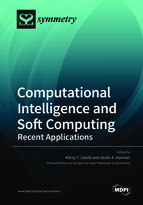Computational Intelligence and Soft Computing: Recent Applications
A special issue of Symmetry (ISSN 2073-8994). This special issue belongs to the section "Computer".
Deadline for manuscript submissions: closed (31 May 2022) | Viewed by 58107
Special Issue Editors
Interests: fuzzy and soft computing systems; telematic systems
Special Issues, Collections and Topics in MDPI journals
Special Issue Information
The closely related fields of computational intelligence and soft computing cover such broad areas as fuzzy systems; artificial neural networks; evolutionary, population-based, and memetic algorithms; cognitive computing; and many others. The common points in these approaches are in the sub-symbolic representation of knowledge, which enables the modeling and highly efficient (often approximate) algorithmic solution of mathematically intractable systems and problems. These methods are also referred to as being "biologically inspired", as the starting ideas in them usually come from microscopic or macroscopic biological "systems", i.e., animals, populations of animals, and even the human body and thinking processes—even though these are often radically simplified in the implementation. It is sometimes amazing how efficient a method inspired by a phenomenon such as biological evolution can be when the optimal solution in a mathematically unsolvable task (e.g., NP-complete bin packing, traveling salesman) must be still sought in real life.
This Special Issue targets the collection of recent applications where such approaches have proved successful and efficient, covering the spectrum of new models ready to be applied in practical modeling (such as new extended fuzzy cognitive map models simulating the convergence behavior of uncertain multiconcept systems), new deep learning, hierarchical and multicomponent fuzzy-rule-based models, decision and control applications, or memetic algorithms for optimizing logistics and related tasks.
The condition for inclusion in the Special Issue is the presentation of either (i) a novel methodological approach that is clearly suitable for real-life applications or (ii) an essentially new and working application with elements of novel approaches or novel combinations of existing methodologies.
Please note that all submissions must be within the general scope of the Symmetry journal.
Prof. Dr. Kóczy T. László
Prof. István A. Harmati
Guest Editors
Manuscript Submission Information
Manuscripts should be submitted online at www.mdpi.com by registering and logging in to this website. Once you are registered, click here to go to the submission form. Manuscripts can be submitted until the deadline. All submissions that pass pre-check are peer-reviewed. Accepted papers will be published continuously in the journal (as soon as accepted) and will be listed together on the special issue website. Research articles, review articles as well as short communications are invited. For planned papers, a title and short abstract (about 100 words) can be sent to the Editorial Office for announcement on this website.
Submitted manuscripts should not have been published previously, nor be under consideration for publication elsewhere (except conference proceedings papers). All manuscripts are thoroughly refereed through a single-blind peer-review process. A guide for authors and other relevant information for submission of manuscripts is available on the Instructions for Authors page. Symmetry is an international peer-reviewed open access monthly journal published by MDPI.
Please visit the Instructions for Authors page before submitting a manuscript. The Article Processing Charge (APC) for publication in this open access journal is 2400 CHF (Swiss Francs). Submitted papers should be well formatted and use good English. Authors may use MDPI's English editing service prior to publication or during author revisions.
Keywords
- computational Intelligence
- soft computing
- fuzzy systems
- artificial neural networks
- connectionist systems
- evolutionary algorithms
- memetic algorithms
- subjective probability
- cognitive systems
- deep learning
- industrial applications
- biomedical applications
- logistics applications
- environmental science applications
- management science applications
- decision support applications
- image processing applications
- modeling and algorithms







